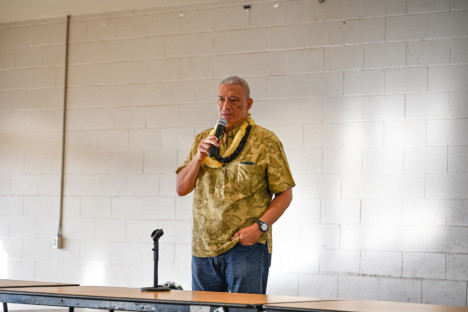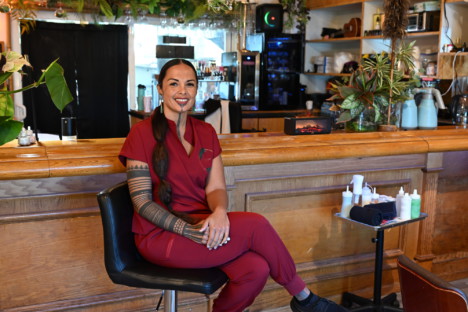Superferry Storm Carries On
Department of Transit starts Environmental Impact Statement.
By Léo Azambuja
The Superferry controversy has generated a lot of turmoil in Hawaii. After months sailing against a sea of legal and technical problems, the vessel remains dry-docked since Feb. 13, with plans to return to operations April 22.
The Alakai, which translates to potbellied or leader, depending on where the okina is placed, is a controversy in itself. After spending $40 million in harbor repairs and $180 million on loan guarantees to the Superferry, the State Government does not have much to show for it.
Adding to tax-payers’ losses, the Department of Transit (DOT) recently announced a new Harbors Modernization Plan. The DOT’s plan will cover six harbors statewide, will last six years, and is budgeted at $842 million, which will come from the Harbors Special Fund. Four of those harbors will go through special renovations to accommodate the Superferry.
A special Legislature session in late 2007 decided the State has to conduct an Environmental Impact Statement (EIS), which will add yet another $1 million in tax payers’ expenses.
Opponents of the Herculean twin-hulled ferry have organized several protests against the company, and have even put themselves in harm’s way, by blocking the boat from entering Nawiliwili Harbor on its second voyage to Kauai.
Superferry opponents on Maui and on Kauai fear that the boat’s operations will bring irreversible environmental damages and traffic chaos to their islands.
As much as environmental and social impacts lurk beneath the surface, such as humpback whale collisions, drug trafficking, invasive species propagation, and traffic jams, Oahu’s large population gives the Superferry a positive outcome in statewide surveys. Neighbor Islands’ surveys have yet to be conducted, but large groups of residents there have showed strong opposition to the Superferry.
Just about eight months ago, Governor Linda Lingle appointed Michael Formby as the DOT Deputy Director, overseeing the harbors’ division. Formby inherited probably the biggest controversy the DOT had to face in recent years.
Just days before the Superferry’s maiden voyage, the Hawaii Supreme Court halted the ferry’s operations by mandating an Environmental Assessment (EA) to be conducted.
The DOT hired Belt Collins Hawaii, Ltd. to prepare an EIS. Lesley Matsumoto, director of environmental consulting at Belt Collins, said the normal course of action would have required an EA before an EIS. But the DOT is now obliged to conduct an EIS because lawmakers decided it during the special Legislature session in late 2007.
Matsumoto explained an EA evaluates general impacts on the environment. If the government decides there are significant impacts, “then the next level is the EIS.”
Matsumoto said the Superferry will continue to operate while the EIS is being prepared. The after-the-fact EIS will evaluate the environmental consequences of the Superferry operations and its secondary impacts. She said the findings will not stop the ferry; instead, the EIS may include additional restrictions on the company’s operations.
When the Supreme Court decision temporarily halted the ferry’s operation last year, Senator Kalani English said he supported the decision. "The EIS was required under the law," he said. "It's been my position all along."
Formby does not agree. According to him, no law had been broken when former DOT Deputy Director Barry Fukunaga gave the Superferry an EA waiver.
“That’s the way business was done,” Formby said, explaining that the Office of Environmental Quality Control (OEQC) used to put certain items on a list of approved exemptions. Formby said "it was the position of DOT Harbors, at the time, that the harbor improvements being implemented by DOT for a ferry were covered by the list of OEQC approved DOT exemptions."
“If you put yourself in Barry Fukunaga’s place, the OEQC’s place, at the time they made those decisions, they’ll tell you they made the right decision,” Formby said.
However, times have changed. “Obviously the Supreme Court doesn’t think it was a good decision,” Formby said.
“Any time you get a landmark decision at the Supreme Court, it changes the way things are done,” Formby said. “The way we do things now is different than the way we did things before the Superferry.”
“For the community it’s for the better,” Formby said. “Now we’re looking at long term effects, secondary impacts.”
Formby wasn’t too sympathetic to Kauai’s Superferry opponents. In 2005, the company hosted informational meetings on Kauai. “Maybe 20 people showed up,” Formby said.
Formby, who says he has not seen any Kauai poll showing majority opposition to the ferry, called opponents a “vocal minority.” Despite saying they have good arguments, Formby believes the community has “to balance the pros and the cons.”
Some of the main concerns of Kauai residents relate to worsening traffic jams. Formby said Norwegian Cruise Lines (NCL) used to bring as much as 2,000 passengers per trip, with as much as 400 of them renting cars. But NCL has pulled one vessel out, and is pulling out the second vessel soon.
In contrast, Formby says that the impact of 100-150 cars the Superferry will transport daily to Kauai is a “very small piece of the puzzle” if compared with the business formerly generated by NCL.
If NCL decides to put back its ships on Hawaiian waters, it would have to re-flag the ships, re-fit them, and ask for Congress approval. The chances of it happening are slim, according to Formby.
The Superferry may not come to Molokai, but its impact here cannot be underestimated.
“It can potentially have impacts on the island and on the residents of the island because it’s transiting the coastal waters,” Formby said. If necessary, the boat can go through the Penguin Banks “if goes at the right speed, in the right time of the season.”
Despite rumors of a proposed dredging in the harbor at Kaunakakai Wharf, Formby assured that the DOT has no plans to do so.
“I’m not aware of any maintenance schedule for Kaunakakai, and we definitely don’t have any new dredging plans for Kaunakakai,” Formby said.
A dredging would only be approved after several environmental studies, a design phase, and finally a lengthy construction phase. “There are definitely no plans for larger vessels to come in,” he said. “If we started today, it would be about 15 years before we finished it, that’s how long it takes; it’s a very long process.”
EIS public meetings
The DOT initiated a series of statewide meetings to gather community input on the EIS currently being prepared by Belt Collins Hawaii Ltd. The island of Molokai was the DOT’s first stopover.
About 30 community members showed up last week Tuesday at Kaunakakai Elementary School to tell Matsumoto and the DOT staff some of the impacts the ferry may have on the Molokai.
Most testifiers were concerned about how the EIS would protect whales and seals from colliding with the vessel. Humpback whales and Hawaiian monk seals are protected by strict federal laws, and some residents do not believe the Superferry is able to avoid hitting them.
Resident Ruth Manu said Young Brothers, in order to accommodate the Superferry schedule in Kahului Harbor, Maui, has changed its scheduled trips to Molokai. The cargo shipper now comes to Molokai two days in a row every week, instead of spacing the trips. As a result, fresh produce availability on Molokai’s grocery store shelves has been compromised.
A series of posters showed potential impacts the Superferry may have in Hawaii. Resident Cheryl Richards wanted to know why the social-economics poster was empty. “If I’m paying the bill, I want to know why the money isn’t coming to our schools,” she said. “I’m paying the taxes and I want to know what the business plan is.”
Richards said she felt the EIS was a “cart-and-pony show.”
The meeting was organized solely to hear comments from the community. DOT officials and Belt Collins associates were not allowed to answer community concerns, which frustrated many testifiers.
“Next time you come, you give us our answers, that’s pono, that’s Hawaiian style,” Manu said.
A recorder kept track of community input, which will be included in the preparation of the EIS.
On March 14 the DOT held two meetings at Farrington High School, on Oahu, drawing only 12 people.
On March 17 the DOT carried two meetings on Maui, and on March 19 it carried two meetings on Kauai. At the time of press, there was no information on those meetings.













